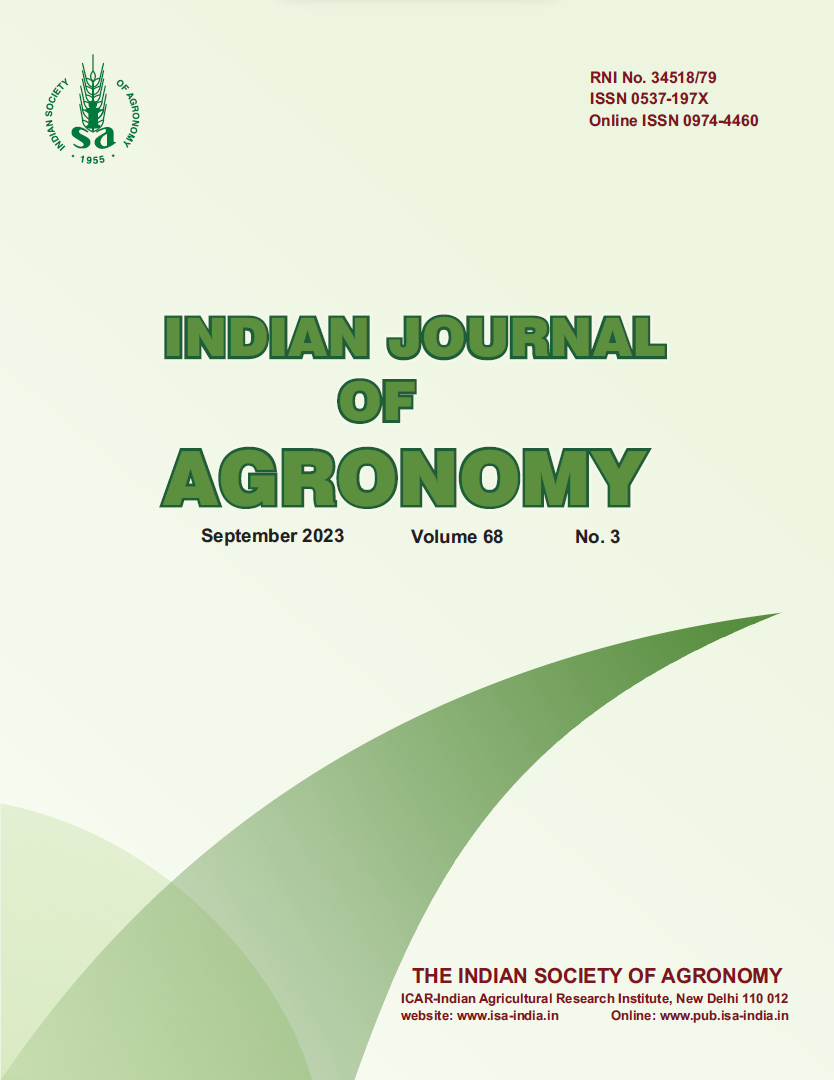Influence of organic amendments and different levels of nitrogen on production potential, economics and energetics of rice (Oryza sativa)–wheat (Triticum aestivum) cropping system
DOI:
https://doi.org/10.59797/ija.v68i3.2801Keywords:
Economics, Nitrogen, Organic amendments, Residual effect, Rice, Wheat, YieldAbstract
A field experiment was conducted during 2018–19 and 2019–20 at the Punjab Agricultural University, Ludhiana and Research Station, Dyal Bharang, Amritsar, to study the influence of organic amendments and nitrogen levels on rice (Oryza sativa L.)-wheat (Triticum aestivum L.) cropping system. In rice, main plot treatments were green manuring (GM), farmyard manure (FYM), poultry manure (PM) and control (NA). Nitrogen levels in sub-plots comprised control (N1), 50 kg N/ha (N2),75 kg N/ha (N3) and 100 kg N/ha (N4). In wheat, residual effect of organic amendments and nitrogen levels applied to preceding rice was evaluated. The statistically highest grain yield of rice was obtained with PM (8.29 t/ha), followed by GM (8.02 t/ha) which was at par with FYM (7.90 t/ha). The lowest rice grain yield was obtained with NA (5.16 t/ha) and its subsequent wheat crop recorded significantly higher grain yield with PM (6.14 t/ha), followed by FYM (5.88 t/ha) and GM (5.72 t/ha). Treatment N4 recorded significantly higher yield than N2 and was at par with N3. Maximum rice-equivalent yield (14.7 t/ha) was recorded with PM, while the highest energy-use efficiency of rice was recorded with green-manure (16.2) as compared to the other treatments. Treatment with the application of PM and N4 recorded significantly the highest economic parameters and system productivity for both rice and wheat crops compared to rest of the treatments.
References
Aulakh, C. S., Singh, Hargopal, Walia, S.S., Phutela, R.P. and Singh, G. 2018. Evaluation of nutrient sources for organic production of rice (Oryza sativa)–wheat (Triticum aestivum) cropping system in north-west India. Indian Journal of Agronomy 63(2): 137–144.
Banjara, T.R., Bohra, J.S., Kumar, S. and Prajapat, K. 2021. Sustainable alternative crop rotations to the irrigated rice–wheat cropping system of IndoGangetic plains of India. Archives of Agronomy and Soil Science 6: 73– 84.
Bukhari, B., Zakaria, S. and Syafruddin, S. 2022. Effect of organic amendments on the water stress resistance of corn varieties during vegetative stage in Ultisols. Indian Journal of Agricultural Research 56(3): 276–282.
Deike, S., Pallutt, B. and Christen, O. 2008. Investigations on the energy efficiency of organic and integrated farming with specific emphasis on pesticide use intensity. European Journal of Agronomy 28: 461–470.
Gill, P.K. and Aulakh, C.S. 2018. Effect of integrated nitrogen management on NPK uptake in rice (Oryza sativa L.). Journal of Applied Natural Science 10(1): 258–261.
Irin, I.J., Biswas, P.K., Ullah, M.J., and Roy, T.S. 2020. Effect of in situ green manuring crops and chemical fertilizer on yield of T. Aman rice and mustard. Asian Journal of Crop Soil Science and Plant Nutrition 2(2): 68–79.
Kaur, N., Vashist, K.K. and Brar, A.S. 2020. Energy and productivity analysis of maize-based crop sequences compared to rice–wheat system under different moisture regimes. Energy 216: 119–286.
PAU. 2020–21. Package and practices for crops of Punjab (Rabi). Punjab Agricultural University, Ludhiana, India, p. 1.
PAU. 2021. Package and practices for crops of Punjab (Kharif). Punjab Agricultural University, Ludhiana, India, p. 1.
Paul, J., Choudhary, A.K., Sharma, S., Savita, B., Dixit, A.K. and Kumar, P. 2016. Potato production through bio-resources: Long-term effects on tuber productivity, quality, carbon sequestration and soil health in temperate Himalayas. Journal of Horticultural Science 213: 152–163.
Rajesh, K., Padma, V., Voleti, S.R., Radhika, K. and Sankar, A.S. 2015. Response of rice (Oryza sativa) varieties on nitrogen use efficiency and yield under different nitrogen levels. Annals of Plant and Soil Research 17: 161–163.
Ransing, D.M. and Tomar, G.S. 2019. Production potential, economics and energetic as influenced by integrated nutrient management in soybean– wheat cropping system. Indian journal of Agronomy 64(3): 298–303.
Thakur, R., Sawarkar, S.D., Vaishya, U.K. and Singh, M. 2011. Impact of continuous use of inorganic fertilizers and organic manure on soil properties and productivity under soybean–wheat intensive cropping of a Vertisol. Journal of the Indian Society of Soil Science 59(1): 74–81.
Walia, S.S., Gill, R.S., Aulakh, C.S. and Kaur, Mandeep. 2014. Energy-efficiency indices of alternative cropping systems of North-West India. Indian Journal of Agronomy 59(3): 359–363.






